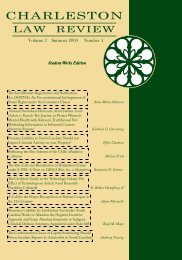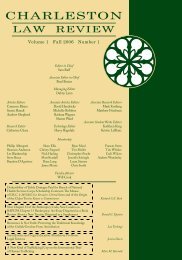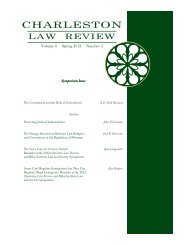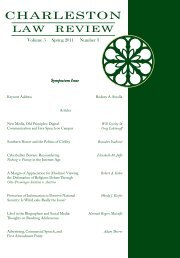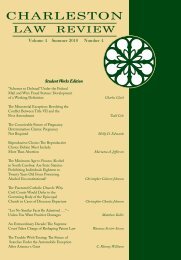Volume 5 Winter 2011 Number 2 - Charleston Law Review
Volume 5 Winter 2011 Number 2 - Charleston Law Review
Volume 5 Winter 2011 Number 2 - Charleston Law Review
You also want an ePaper? Increase the reach of your titles
YUMPU automatically turns print PDFs into web optimized ePapers that Google loves.
CHARLESTON LAW REVIEW [<strong>Volume</strong> 5allowances were a result of the low esteem in which lawyers wereheld in the Colonial era. 22It was not long before lawyers in the United States werebeing paid mostly by their own clients rather than by what theycould recover statutorily as “costs” from the defeated party. Asone state court surmised in 1836, when discussing statutesgoverning legal fees, “[w]hatever might have been true when theseveral statutes giving costs, [sic] were enacted, we cannot, atthis day, shut our eyes to the truth known by every body [sic],that taxable costs afford a very partial and inadequateremuneration for the necessary expenses of defending anunfounded suit . . . .” 23 By 1836, clients were already payingattorneys more in fees than prescribed by statute.In 1840, the Delaware Court of Errors and Appeals upheldand enforced a fee agreement between a lawyer and his client,making what was then a bold statement: “I affirm that it hasnever been regarded as the violation of any law, much less of anycriminal law of this State, for a lawyer to contract for acontingent feea portion of what was recovered.” 24So, by the middle of the nineteenth century in this country,lawyers were negotiating fees with their clients as “privatebusinessmen,” as Leubsdorf states. 25 What, though, were thosearrangements? Though no less a lawyer than Abraham Lincolnsaid, “a lawyer’s time is his stock in trade,” lawyers did not billclients by the hour. 26 For decades, lawyers made their moneyfrom a combination of collecting statutory (albeit low) fees fromthe losing side of litigation and from several other methods,“including set fees for particular tasks, annual retainers, adiscretionary ‘feels right’ amount, and contingency fees, whichthe American Bar Association (ABA) approved as ethical inown clients for extra-statutory rates in the form of “gifts,” and he cites JohnAdams as one who “managed to do pretty well.” Id.22. M.H. Hoeflich, Legal Fees in Ninteteenth-Century Kansas, 48 U. KAN.L. REV. 991, 991 (2000).23. Whipple v. Fuller, 11 Conn. 582, 585 (1836).24. Bayard v. McLane, 3 Del. (3 Harr.) 139, 159 (1840).25. Leubsdorf, supra note 15, at 17.26. Martin v. Univ. of S. Ala., 911 F.2d 604, 611 (11th Cir. 1990).176



